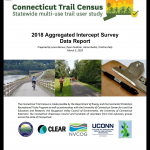Data should not be generalized
The citizen science based structure of this study creates some significant challenges with regard to generalization and communication of the data collected. The user identified nature of the sampling collection points means that sites selected to participate in the Trail Census may not necessarily be an accurate sample of bicycle/pedestrian trails in the state. Further, given that the data collected represents use within a particular community around a data collection point, the data cannot be used to accurately estimate total use along the entire length of a trail.
Following the pilot period of data collection in 2017, a significant effort was made to identify and reduce the potential sources of error. Because this will never be a fully research based design however, the data should alway be viewed as not broadly generalizable or representative of the full population of trail users. The goals in this review effort were to decrease the margin of error of volunteer administered intercept surveys while also increasing Site Coordinators and volunteers’ ability to successfully administer them.
Read the meta data
Each spreadsheet download on our website includes a “Read Me” tab with information about the data. We encourage you to take time to review this before using the data.
Read more about limitations on the Methods page.



